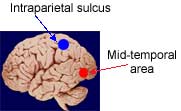 | Juggling Juggles the Brain |  |
 | Juggling Juggles the Brain |  |
 Feburary 3, 2004
Feburary 3, 2004Street performers, circus entertainers and clowns: they can all juggle. Neuroscientists are now getting into the juggling act. Brain researchers at the University of Regensburg (Germany) have found that learning to juggle can change brain structure. The researchers divided 24 people into two groups:
Magnetic resonance imaging was used to measure the size of different areas within the brains of the subjects. Brain scans were taken before anyone practiced juggling, three months after the jugglers practiced and three months after the jugglers stopped practicing.
Results At the first brain scan, there were no differences in the
brains of the study participants. However, at the second brain scan, a
significant expansion was found in two areas (the mid-temporal area and
left posterior intraparietal sulcus) within the brains of jugglers.
These two areas of the brain are important for processing information
related to moving objects. No changes were seen in the brains of
non-jugglers at the second scan. At brain scan #3, after the jugglers
stopped juggling, the brain expansion seen earlier was reduced. At the first brain scan, there were no differences in the
brains of the study participants. However, at the second brain scan, a
significant expansion was found in two areas (the mid-temporal area and
left posterior intraparietal sulcus) within the brains of jugglers.
These two areas of the brain are important for processing information
related to moving objects. No changes were seen in the brains of
non-jugglers at the second scan. At brain scan #3, after the jugglers
stopped juggling, the brain expansion seen earlier was reduced.  These data suggest that learning new skills can alter brain structure. However, it is unclear what exactly caused the brain changes. The expansion in the two brain areas may have been caused by an increase in the number of nerve cells, glial cells or synapses. Further research may provide therapies for people who have brain damage. For example, it may be possible to design an exercise program to target a specific area of the brain to repair damage and restore function. |
Reference and more information:
|
| BACK TO: | Neuroscience in the News | Exploring the Nervous System | Table of Contents |
![[email]](./gif/menue.gif) Send E-mail |
 Fill out survey |
 Get Newsletter |
 Search Pages |